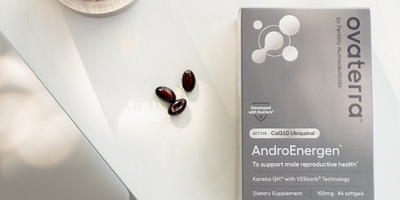When preparing or trying to get pregnant, it’s important to look at both male and female reproductive health. Just as women need “quality” eggs, men need healthy sperm to create a healthy embryo with a strong potential to grow into a healthy baby.
But what is “healthy sperm,” anyway? It’s a combination of what the sperm looks like under a microscope, how well it functions, as well as its genetic integrity. Let’s discuss everything you need to know about sperm health to support your chances of a successful pregnancy.
Related: Sperm count declined by over 60% in the last 50 years. What does that mean for human fertility?
Why is healthy sperm important?
Semen quality and sperm concentration is integral to your chances of conception. Although doctors think that eggs play a bigger role in embryo quality than sperm, sperm quality is linked to the growth and development of a baby after the sperm fertilizes the egg.
How do you know sperm is healthy?
Quantity, movement, and shape are three key visual characteristics of healthy sperm in a normal semen analysis. These characteristics, observed under a microscope, are an indication of your level of male reproductive health.
The more, the merrier (sperm count and concentration)
A healthy amount of sperm in a single ejaculate is at least 15 million sperm per mL of semen - the substance ejaculated during sexual arousal - or 39 million total sperm in a single ejaculate. To put these numbers in context, some men have over 200 million sperm per mL.
Semen is about two to five percent sperm; the rest is seminal plasma. Sperm count and concentration are important, because the more sperm the semen has, the more likely one of them will fertilize the egg.
Let the race begin! (motility)
It’s a race to get to an egg once sperm enters the female reproductive system. Sperm must successfully move through the cervix, past the uterus and to the fallopian tube, where it will hopefully find a mature egg during the fertile window.
The sperm’s ability to move is called motility, another sperm health factor doctors look at. Pregnancy can still occur with less than half of the sperm moving, but you want at least 40 percent to have motility.
An important sub-component of sperm motility is the progressive motility - the sperm’s ability to move forward in a more or less straight line. Some sperm have good motility, but end up going around in circles, instead of moving forward, which makes it difficult for it to progress through the fallopian tubes.
Shape (morphology)
Healthy sperm should have a smooth, oval-shaped head about 5-6 micrometers in length that contains the sperm’s DNA, with a cap covering 40 to 70 percent of the sperm’s head, a midsection that hosts the energy-producing mitochondria, and a long tail that propels the sperm forward. There should be no abnormalities in any of the parts.
Does genetics play a role?
Sperm, like eggs, carries genetic material within it. Sperm DNA fragmentation refers to damages to the DNA inside the sperm cells. Age, lifestyle choices, infection, or environmental toxins like BPA and PFAS can cause fragmentation.
Certain genetic mutations can be passed from parent to child. As our understanding of genetics increases, our ability to look to genetics in terms of fertility has been increasing. Genetics is now considered one of the most important contributors to male reproductive health.
What makes sperm healthy?
Men can improve their reproductive health by eating a balanced diet, practicing safe sex, and managing stress. While lifestyle factors alone cannot guarantee healthy sperm (or sperm quality) and reproductive success, some of these factors are within your control.
Eating a healthy diet
As always, eating a healthy diet can not only help your systemic health and wellbeing, but it can also affect your sperm. In particular, diets similar to the Mediterranean diet have been suggested as a particularly sperm-healthy way of eating. Eating a well-balanced diet with the needed vitamins, minerals, and antioxidants may support sperm health. Several key nutrients have been linked to sperm health:
- Antioxidants like Vitamin C and Vitamin E
- Vitamin D
- Minerals like zinc and selenium
- Ubiquinol or Coenzyme Q10
- Omega-3 fatty acids
Healthy sexual activity
Limiting the number of sexual partners can support your male reproductive health. The more sexual partners you have, the higher your chances of contracting a sexually transmitted disease. Some STIs, like gonorrhea and chlamydia, can hold you back on the TTC journey.
How often you ejaculate can also affect your sperm quality. This is why men are often advised to abstain for 2 to 6 days before semen analysis, but no more than 7 days. That said, how much effect abstinence has on sperm quality is debated.
Stress Management
Studies have suggested that stress can cause testosterone levels to drop and the number of sperm to decline. Of course, eliminating stress entirely is unrealistic. The key, when trying to conceive, is to manage your stress in a healthy way that works for you.
What is the difference between semen and sperm?
Semen is the liquid ejaculated out of a penis during an orgasm. This fluid facilitates the transportation of sperm to fertilize an egg. Semen is made up of water, plasma, mucus, and a small amount of sperm.
Semen also contains nutrients like calcium, citrate, fructose, magnesium, and potassium. These nutrients provide the sperm with everything it needs to survive for 4-5 days after ejaculation.
Why does semen change color?
Changes in semen can happen because of natural reasons, infections, or underlying health issues. A healthy semen is white or light gray in color. If you notice a change in sperm color and other symptoms, you should always consult your healthcare provider, as the change may be a sign of reproductive issues.
What does red, pink, and orange semen mean?
- Burst blood vessel: If a blood vessel bursts in the tract that sperm travels through, blood can find its way into semen, turning it a shade of red. Bright red might indicate fresh blood, while orange might be a sign of old blood.
- High blood pressure: High blood pressure, or hypertension, may cause changes in your sperm color and health. Studies have shown a chance of poor quality sperm production in males diagnosed with high blood pressure. Hypertension affects about 30 percent of all males in the United States.
- Infection: Pink, red, or orange sperm may also signify various sexually transmitted diseases, such as chlamydia, gonorrhea, or herpes.
- Prostate issues: Infections in your prostate may also cause abnormally colored sperm. You may notice other symptoms, like painful or frequent urination.
What does brown or black semen mean?
- Heavy bleeding and trauma: Black or brown semen may be associated with heavy bleeding or old blood caused by STIs or an untreated UTI.
What does yellow or green semen mean?
- Diet: Certain foods that contain coloring or sulfur, including turmeric, garlic and asparagus, can cause semen to turn yellow.
- Urine: Flow or urine is blocked when a male has an erection. After ejaculation, urine can enter the urethra, causing the semen to be slightly yellow.
- Infection: Some infections can cause semen to become yellow or green. This includes infections in the prostate, STIs or UTIs.
- Infrequent ejaculation: If you abstain from sexual intercourse or masturbation for a while, semen can become old and yellow in color.
- Jaundice: Jaundice happens when there is a buildup of a waste product called bilirubin in your body. This waste product may cause your skin, hair, eyes, and even semen to turn yellow.
- High white blood cell count: Leukocytospermia refers to a high white blood cell count in the semen. Infections can cause your white blood cells to increase, possibly making your semen yellow.
What can different semen textures mean?
Semen usually has a jelly-like texture but can sometimes change in texture for various reasons. Drug use, alcohol consumption, infrequent ejaculation, diet, and physical activity can all change the texture of your semen.
When semen is thicker than normal, it may be because there is a large amount of sperm in the semen. You may be dehydrated. Having a lot of healthy sperm in your semen can increase your chances of a pregnancy, but thick semen can also constrict sperm’s movement or be a sign of an underlying condition.
When should you see a doctor?
If your semen frequently changes colors or texture, you may want to see your healthcare provider. Ignoring symptoms for an extended period may create more significant health issues, going beyond reproductive health. Always check in with your doctor when you notice a change in your sperm health.
What can you do to support healthy sperm?
Scientists estimate that 30 to 80 percent of male reproductive issues can have their roots in oxidative stress and a decreased level of antioxidant capacity. Studies have shown that several nutrients in healthy foods and supplements can help support healthy sperm.
The nutrients that may support sperm health include Vitamin C, Vitamin E, and CoQ10. Some studies suggest that you can support healthy motility, quantity, and morphology by using supplements containing antioxidants.
Are there reproductive health supplements for men?
There are supplements designed specifically to support male reproductive health. Not all have the same amount of scientific evidence, but if you are preparing or trying to have a baby, rounding out your nutritional foundation with high-quality supplements to support sperm health may be a good idea. There are even prenatal vitamins for men, too. Some of these male prenatals focus on nutrients specific to male reproductive health, like CoQ10 and antioxidants we reviewed above.
The bottom line
Having healthy sperm is essential on your journey. The shape of sperm, its movement, the integrity of the DNA it contains, as well as health of the semen that carries the sperm are all important aspects of normal male reproductive health.
Please reach out if we can answer any questions. We are with you.















